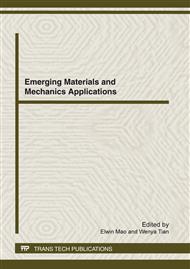[1]
Y. Satyawali , M. Balakrishnan, Performance enhancement with powdered activated carbon (PAC) addition in amembrane bioreactor (MBR) treating distillery effluent, J. Journal of Hazardous Materials. 170(2009) 457–465.
DOI: 10.1016/j.jhazmat.2009.04.074
Google Scholar
[2]
X.H. Ren, H.K. Shon and N.J. Jang, Novel membrane bioreactor (MBR) coupled with a nonwoven fabric filter for household wastewater Treatment, J. Water Research. 44(2010) 751-760.
DOI: 10.1016/j.watres.2009.10.013
Google Scholar
[3]
D.D. Yuan, Y.B. Fan and Y. Yu, Study of a membrane bioreactor with glass fiber flat grille modules and the modules optimization based on the localcritical flux theory, J. Water Research. 44 (2010) 997-1105.
DOI: 10.1016/j.watres.2009.10.015
Google Scholar
[4]
Y. Kiso, Y. J. Jung, T. Ichinari, M. Park, T. Kitao, K. Nishimura and K. Min, Wastewater treatment performance of a filtration bioreactor equipped with a mesh as a filter material, J. Water Research. 34(2000) 4143-4150.
DOI: 10.1016/s0043-1354(00)00201-3
Google Scholar
[5]
M. R. Alavi Moghaddam, H. Satoh and T. Mino, Effect of important operational parameters on performance of coarse pore filtration activated sludge process, J. Water Science Technology. 46(2002)229-236.
DOI: 10.2166/wst.2002.0246
Google Scholar
[6]
G. T. Seo, B. H. Moon, T. S. Lee, T. J. Lim and I.S. Kim, Non-woven fabric filter separation activated sludge reactor for domestic wastewater reclamation, J. Water Science Technology. 47(2002)133-138.
DOI: 10.2166/wst.2003.0035
Google Scholar
[7]
V. T. Kuberkar and R. H. Davis, Modeling of fouling reduction by secondary membranes, J. Journal Membrane Science . 168(2000)158-243.
DOI: 10.1016/s0376-7388(99)00324-5
Google Scholar
[8]
A.R. Dincer and F. Kargi, Salt inhibition kinetics in nitrification of synthetic saline wastewater, J. Enzyme and Microbial Technology . 28(2001) 661–665.
DOI: 10.1016/s0141-0229(01)00312-x
Google Scholar
[9]
A. R. Dincer and F Kargi, Effects of operating parameters on performances of nitrification and denitrification processes, J. Bioprocess Eng. | 23(2000) 75– 80.
DOI: 10.1007/s004499900126
Google Scholar
[10]
A. R. Dincer and F Kargi, Kinetics of sequential nitrification and denitrificationprocesses, J. Enzyme & Microbial Technology. 27(2000) 37–42.
Google Scholar


